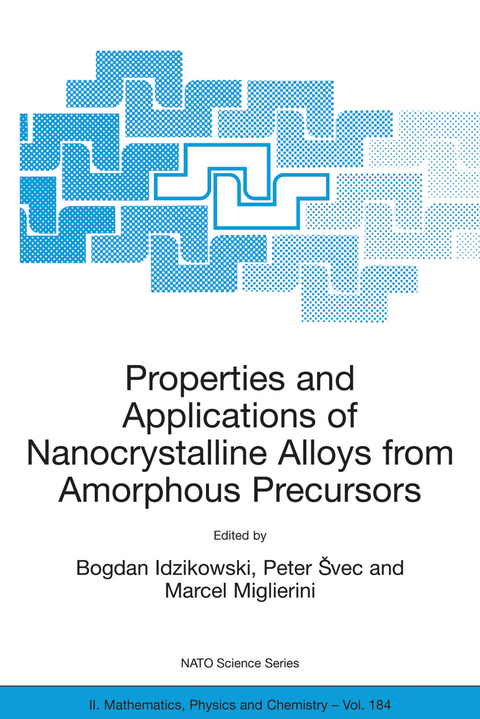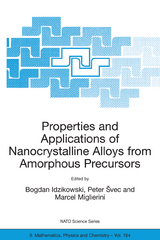Properties and Applications of Nanocrystalline Alloys from Amorphous Precursors
Springer-Verlag New York Inc.
978-1-4020-2963-9 (ISBN)
Metallic (magnetic and non-magnetic) nanocrystalline materials have been known for over ten years but only recent developments in the research into those complex alloys and their metastable amorphous precursors have created a need to summarize the most important accomplishments in the field. This book is a collection of articles on various aspects of metallic nanocrystalline materials, and an attempt to address this above need.
The main focus of the papers is put on the new issues that emerge in the studies of nanocrystalline materials, and, in particular, on (i) new compositions of the alloys, (ii) properties of conventional nanocrystalline materials, (iii) modeling and simulations, (iv) preparation methods, (v) experimental techniques of measurements, and (vi) different modern applications. Interesting phenomena of the physics of nanocrystalline materials are a consequence of the effects induced by the nanocrystalline structure. They include interface physics, the influence of the grain boundaries, the averaging of magnetic anisotropy by exchange interactions, the decrease in exchange length, and the existence of a minimum two-phase structure at the atomic scale.
Attention is also paid to the special character of the local atomic ordering and to the corresponding interatomic bonding as well as to anomalies and particularities of electron density distributions, and to the formation of metastable, nanocrystalline (or quasi-crystalline) phases built from exceptionally small grains with special properties. Another important focus of attention are new classes of materials which are not based on new compositions, but rather on the original and special crystalline structure in the nanoscale.
Fe-M-B (M = IVa TO VIa Metal) Nanocrystalline Soft Magnetic Materials.- The Random Anisotropy Model.- Some Aspects of the Crystallization of Finemet- and Nanoperm-Like Alloys.- Magnetically Soft Nanocrystalline Materials Obtained by Devitrification of Metallic Glasses.- The Initial Stage of Nanocrystallization in Fe-Cu-Nb-Si-B Ferromagnetic Alloys.- Cluster Structure and Thermodynamics of the Formation of Nanocrystalline Phases.- Kinetic Characterization of Nanocrystal Formation in Metallic Glasses.- Kinetics of the Nonisothermal Primary Crystallization of Metallic Glasses: Nanocrystal Development in Fe85B15 Amorphous Alloy.- Structural Relaxation and Nanocrystallization in the Initial Stage of Amorphous Alloys Studied by Curie Temperature Measurements.- Nanocrystallization Process of the Hitperm Fe-Co-Nb-B Alloys.- Low Temperature Magnetic Properties of Nanocrystalline Co-Nb-Cu-Si-B Alloys.- Induced Anisotropy and Magnetic Properties at Elevated Temperatures of Co-Substituted Finemet Alloys.- Structure and Magnetic Properties of the Fe-Cu-Nb-Si-B Powder Prepared by Milling.- Magnetic Decoupling in Soft Magnetic Nanocrystalline Alloys.- Design and Preparation of New Soft Magnetic Amorphous Ferromagnets.- Formation of Nanocrystalline Metastable Phases in Fe-Ni-Zr-B Amorphous Alloys.- Applications of Amorphous Magnetic Alloys.- Magnetic Crystalline Transition Metal Ribbons Prepared by Melt-Spinning and Reactive Annealing.- Percolation and Fractal Clusters in Amorphous Metals.- Neutron Irradiation Effect on Fe-Based Alloys Studied by Mössbauer Spectrometry.- Application of Different Analytical Techniques in the Understanding of the Corrosion Phenomena of Non-Crystalline Alloys.- Monte Carlo Simulations of Model Particles Forming Phases of Negative Poisson Ratio.- MagneticProperties of Nanostructured Materials.- Al-Rare Earth-Transition Metal Alloys: Fragility of Melts and Resistance to Crystallization.- On Different Mechanisms of Primary Crystallization in Al-Ni-La-Zr Amorphous Alloys.- Atomic Structure, Interatomic Bonding and Mechanical Properties of the Al3V Compound.- Amorphous and Nanostructured Al-Fe and Al-Ni Based Alloys.- Bulk Amorphous Samples from Al-Mm-Ni System.- Al-Based Amorphous Alloys at the Limit of Glass Forming Ability.- Magnetic Softening of Metallic Glasses by Current Annealing Technique.- Interpretation of the Glass Transition Temperature from the Point of View of Molecular Mobility.- The Effect of Thermal Relaxation on the Short-Range Order in Melt-Quenched Zr-Co and Zr-Ni Alloys.- Magnetic Properties of Zr-3d Glassy Alloy Systems.- Intergranular Phase in Nanocrystalline Alloys: Structural Aspects and Magnetic Properties.- MÖssbauer Effect Study of Fe Grains in Nanocomposites.- Radio-Frequency MÖssbauer Spectroscopy in the Investigation of Nanocrystalline Alloys.- Ferromagnetic Resonance in Amorphous and Nanocrystalline Materials.- Magnetic Microstructure of Amorphous/Nanocrystalline Fe-Mo-Cu-B Alloys.- Microstructure — Magnetic Properties Relationship in Nano-Clustered Glassy Magnets.
| Reihe/Serie | NATO Science Series II: Mathematics, Physics and Chemistry ; 184 |
|---|---|
| Zusatzinfo | XII, 456 p. |
| Verlagsort | New York, NY |
| Sprache | englisch |
| Maße | 156 x 232 mm |
| Themenwelt | Naturwissenschaften ► Chemie ► Analytische Chemie |
| Naturwissenschaften ► Physik / Astronomie ► Atom- / Kern- / Molekularphysik | |
| Naturwissenschaften ► Physik / Astronomie ► Elektrodynamik | |
| Naturwissenschaften ► Physik / Astronomie ► Festkörperphysik | |
| Naturwissenschaften ► Physik / Astronomie ► Thermodynamik | |
| Technik ► Maschinenbau | |
| Technik ► Umwelttechnik / Biotechnologie | |
| ISBN-10 | 1-4020-2963-2 / 1402029632 |
| ISBN-13 | 978-1-4020-2963-9 / 9781402029639 |
| Zustand | Neuware |
| Haben Sie eine Frage zum Produkt? |
aus dem Bereich




